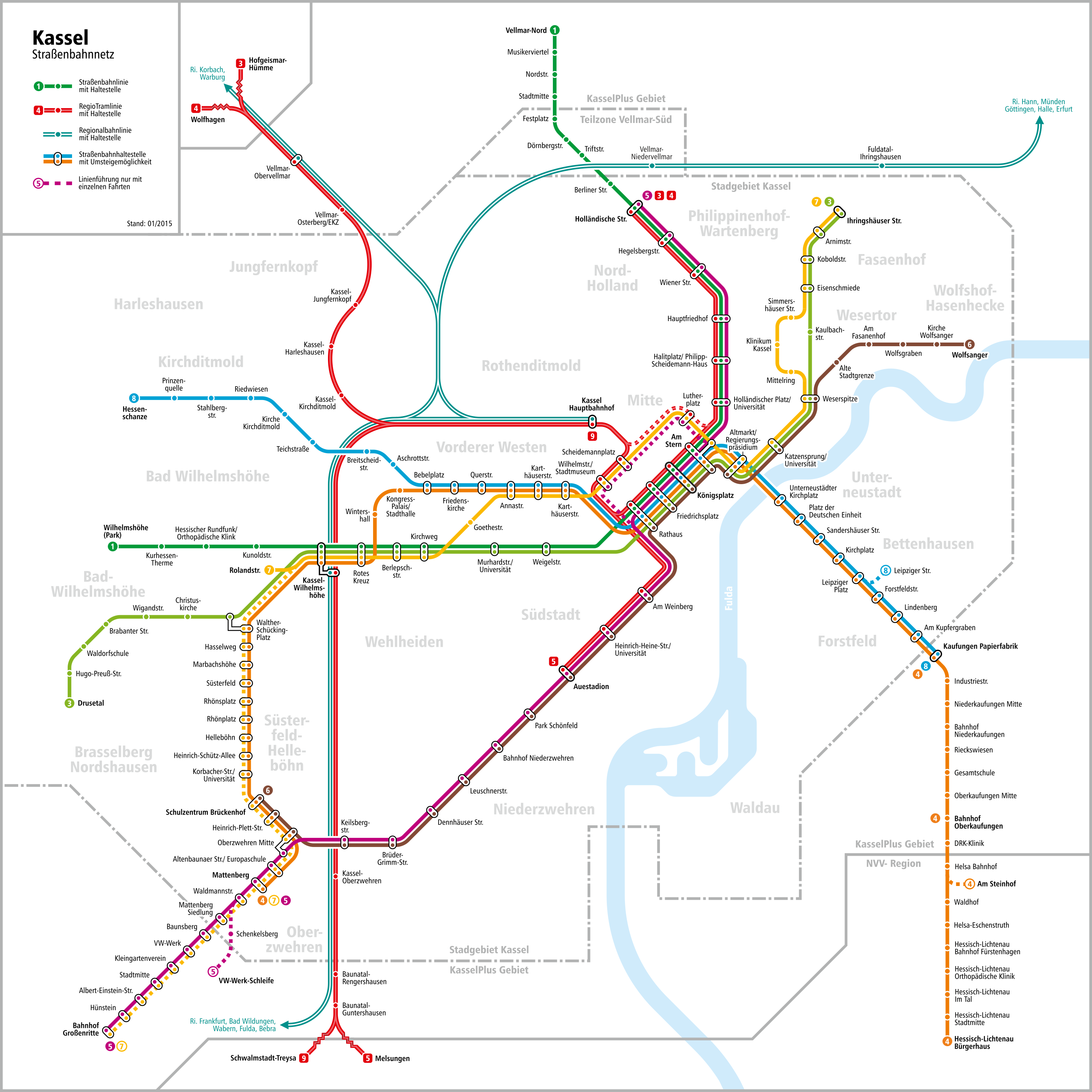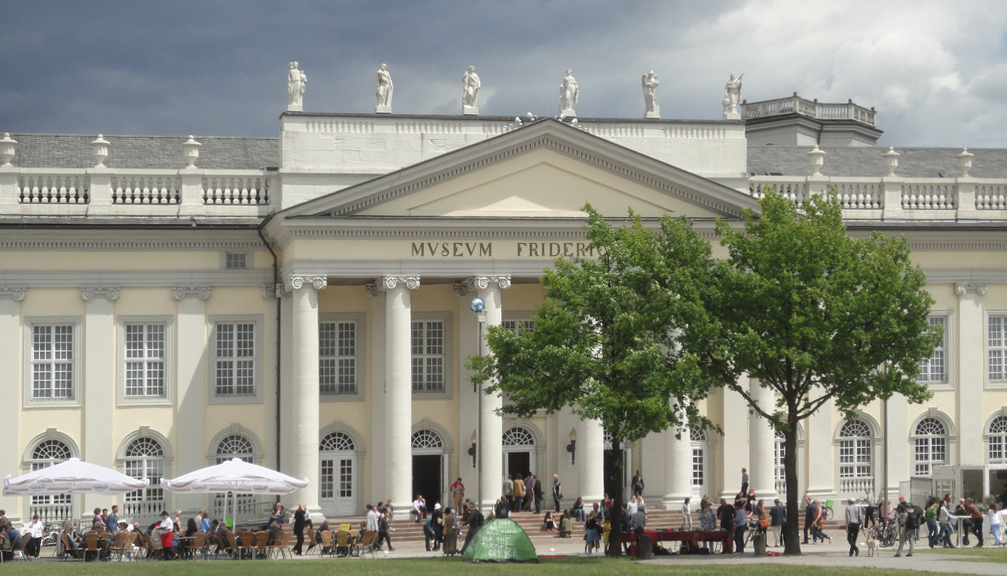|
Trams In Kassel
The Kassel tramway network is a transport network, network of tramways, forming part of the public transport system in Kassel, a city in the north of the States of Germany, federal state of Hesse, Germany. , the Kassel tram network is made up of seven regular tramlines. Opened in 1877 as a steam tramway from Wilhelmshöhe the Königsplatz (Royal Square), the network has been operated since 1897 by Kasseler Verkehrs-Gesellschaft (KVG), and is integrated in the Nordhessischer Verkehrsverbund (NVV). The track gauge is . There existed also a narrow gauge network to the Hercules monument (Kassel), Hercules monument. The network was extended gradually into the surrounding area, partly as conventional tramways, and partly as a tram-train ''Kassel RegioTram, RegioTram'' network. History In the summer of 1870 a horse-drawn omnibus line opened as part of an industrial exhibition from 1 June to 5 October 1870. The growth of the city made it attractive to operate a steam tram which was op ... [...More Info...] [...Related Items...] OR: [Wikipedia] [Google] [Baidu] |
Kassel
Kassel (; in Germany, spelled Cassel until 1926) is a city on the Fulda River in northern Hesse, Germany. It is the administrative seat of the Regierungsbezirk Kassel and the district of the same name and had 201,048 inhabitants in December 2020. The former capital of the state of Hesse-Kassel has many palaces and parks, including the Bergpark Wilhelmshöhe, which is a UNESCO World Heritage Site. Kassel is also known for the '' documenta'' exhibitions of contemporary art. Kassel has a public university with 25,000 students (2018) and a multicultural population (39% of the citizens in 2017 had a migration background). History Kassel was first mentioned in 913 AD, as the place where two deeds were signed by King Conrad I. The place was called ''Chasella'' or ''Chassalla'' and was a fortification at a bridge crossing the Fulda river. There are several yet unproven assumptions of the name's origin. It could be derived from the ancient ''Castellum Cattorum'', a castle of the ... [...More Info...] [...Related Items...] OR: [Wikipedia] [Google] [Baidu] |
Tram Transport In Germany
A tram (called a streetcar or trolley in North America) is a rail vehicle that travels on tramway tracks on public urban streets; some include segments on segregated right-of-way. The tramlines or networks operated as public transport are called tramways or simply trams/streetcars. Many recently built tramways use the contemporary term light rail. The vehicles are called streetcars or trolleys (not to be confused with trolleybus) in North America and trams or tramcars elsewhere. The first two terms are often used interchangeably in the United States, with ''trolley'' being the preferred term in the eastern US and ''streetcar'' in the western US. ''Streetcar'' or ''tramway'' are preferred in Canada. In parts of the United States, internally powered buses made to resemble a streetcar are often referred to as "trolleys". To avoid further confusion with trolley buses, the American Public Transportation Association (APTA) refers to them as " trolley-replica buses". In the Uni ... [...More Info...] [...Related Items...] OR: [Wikipedia] [Google] [Baidu] |
Trams In Germany
Germany has an extensive number of tramway networks (Straßenbahn in German). Some of these networks have been upgraded to light rail standards, called Stadtbahn in German. Straßenbahn and Stadtbahn schemes are usually operated on the legal foundation of the BOStrab, the Tramways Act of Germany. Tramways served as the primary means of urban transport in Germany until the early 1960s when they were systematically replaced by buses. However, in the 1980s tramways began to reappear; experts spoke of the 'renaissance of the tramway'. In the 1990s tramways had again become a modern means of public transport. Popular notions of fashion have been used by scholars to explain this cycle of acceptance rejection and restoration. Tramways were a highly visible manifestation of commodity culture and People projected onto them not just travel destinations but more broadly their desires, ideas and beliefs.Barbara Schmucki, "Fashion and technological change: Tramways in Germany after 1945." T ... [...More Info...] [...Related Items...] OR: [Wikipedia] [Google] [Baidu] |
List Of Town Tramway Systems In Germany
This is a list of town tramway systems in Germany by ''Land''. It includes all tram systems, past and present. Cities with currently operating systems, and those systems themselves, are indicated in bold and blue background colored rows. Those tram systems that operated on other than standard gauge track (where known) are indicated in the 'Notes' column. Baden-Württemberg Bavaria (Bayern) Berlin Brandenburg Bremen Hamburg Hessen Lower Saxony (Niedersachsen) Mecklenburg-Western Pomerania (Mecklenburg-Vorpommern) North Rhine-Westphalia (Nordrhein-Westfalen) Rhine-Ruhr (Rhein-Ruhr) '' Ruhrgebiet (Ruhr Area)'' towns in geographic order, west to east: '' ''Bezirksregierung Düsseldorf'' (Düsseldorf Region) and '' ''Bezirksregierung Arnsberg'' (Arnsberg Region) towns not tabulated above, in geographic order, west to east: Note for Rheydt: Amalgamated with Mönchengladbach from 29 July 1929 to 31 July 1933, and again from 1 January 1975. Note ... [...More Info...] [...Related Items...] OR: [Wikipedia] [Google] [Baidu] |
Documenta
''documenta'' is an exhibition of contemporary art which takes place every five years in Kassel, Germany. The ''documenta'' was founded by artist, teacher and curator Arnold Bode in 1955 as part of the Bundesgartenschau (Federal Horticultural Show) which took place in Kassel at that time. It was an attempt to bring Germany up to speed with modern art, both banishing and repressing the cultural darkness of Nazism. This first ''documenta'' featured many artists who are generally considered to have had a significant influence on modern art (such as Picasso and Kandinsky). The more recent editions of the event feature artists based across the world, but much of the art is site-specific. Every ''documenta'' is limited to 100 days of exhibition, which is why it is often referred to as the "museum of 100 days". ''Documenta'' is not a selling exhibition. Etymology of ''documenta'' The name of the exhibition is an invented word. The term is supposed to demonstrate the intention of ... [...More Info...] [...Related Items...] OR: [Wikipedia] [Google] [Baidu] |
Wrap Advertising
Wrap advertising or a vehicle wrap is known as the marketing practice of completely or partially covering (wrapping) a vehicle in a vinyl material, which may be for a color change, advertising or custom delivery. The result of this process is essentially a mobile billboard. Wrap advertising can be achieved by painting a vehicle's outer surface, but an increasingly ubiquitous practice in the 21st century involves the use of large vinyl sheets as " decals". The vinyl sheets can later be removed with relative ease, drastically reducing the costs associated with changing advertisements. While vehicles with large, flat surfaces (such as buses and light-rail carriages) are often used, automobiles can also serve as hosts for wrap advertising, despite consisting of more curved surfaces. Wrap advertising is also used in the magazine and publishing industries. History Until the age of the automobile, train companies were the largest industry to paint company names and logos for distinc ... [...More Info...] [...Related Items...] OR: [Wikipedia] [Google] [Baidu] |
Art – Das Kunstmagazin
''Art – Das Kunstmagazin'' is a monthly art magazine founded by Wolf Uecker and first published by Gruner + Jahr in 1979. Its original editor-in-chief, Axel Hecht, was replaced by Tim Sommer in 2005. The magazine features both new and established contemporary art Contemporary art is the art of today, produced in the second half of the 20th century or in the 21st century. Contemporary artists work in a globally influenced, culturally diverse, and technologically advancing world. Their art is a dynamic com ...ists across all disciplines (including painting, sculpture, design, and video art) as well as reports on exhibitions and projects. In 2001, ''Art'' assimilated the Swiss monthly art magazine ''Artis – Zeitschrift für neue Kunst'' (), which had been published by Hallwag, Bern and Stuttgart-Ostfildern since 1950. References Further reading * External links * Publisher's profile {{DEFAULTSORT:Art Das Kunstmagazin Visual arts magazines published in Ger ... [...More Info...] [...Related Items...] OR: [Wikipedia] [Google] [Baidu] |
Hauptbahnhof
Central stations or central railway stations emerged in the second half of the nineteenth century as railway stations that had initially been built on the edge of city centres were enveloped by urban expansion and became an integral part of the city centres themselves.Kellerman, Aharon. "Central railway stations" in ''Daily Spatial Mobilities: Physical and Virtual'', Oxford: Routledge, 2012. pp. 159-161. Bán, D. ''The railway station in the social science.'' The Journal of Transport History, 28, 289-93, 2007. As a result, "Central Station" is often, but not always, part of the proper name for a railway station that is the central or primary railway hub for a city. Development Emergence and growth Central stations emerged in the second half of the nineteenth century during what has been termed the "Railway Age".Richards, Jeffrey and John M. MacKenzie, ''The Railway Station'', Oxford: OUP, 1986. Initially railway stations were built on the edge of city centres but, subsequent ... [...More Info...] [...Related Items...] OR: [Wikipedia] [Google] [Baidu] |
Bergpark Wilhelmshöhe
Bergpark Wilhelmshöhe is a landscape park in Kassel, Germany. The area of the park is , making it the largest European hillside park, and second largest park on a hill slope in the world. Construction of the ''Bergpark'', or "mountain park", began in 1689 at the behest of the Landgraves of Hesse-Kassel and took about 150 years. The park is open to the public today. Since 2013, it has been a UNESCO World Heritage Site because of its monumental Baroque architecture and its unique fountains and water features. Geography Location , a ''Stadtteil'' of Kassel in northern Hesse, is situated west of the city centre at the foot of the Habichtswald hill range. It is also known for Kassel-Wilhelmshöhe station on the Hanover–Würzburg high-speed railway line. Description The park comprises an area of about , stretching from Kassel up to the Karlsberg mountain at . At the summit of the park stands the Hercules monument, a 40-meter high pyramid with a 8.5-meter bronze statue of Hercule ... [...More Info...] [...Related Items...] OR: [Wikipedia] [Google] [Baidu] |
Kassel RegioTram
The Kassel RegioTram is a tram-train light rail system in Kassel, Hesse, Germany. Kassel's tram-train system follows the Karlsruhe model, and has been in full operation since 2007. With special RegioTram tramcars, continuous trips between the Deutsche Bahn heavy rail network and Kassel's city tram network are easily possible, thus avoiding transfers requiring long walking distances between trains of the regional rail system and trams of the Kassel city system. The operator of the RegioTram network was, until December 2013, RegioTram mbH, a joint venture between Regionalbahn Kassel (RBK), a subsidiary of the Kasseler Verkehrs-Gesellschaft (KVG), and DB Regio. Since 9 December 2013, the RegioTram is operated by a consortium of the KVG and Hessische Landesbahn (HLB). The system is integrated in the Nordhessischer Verkehrsverbund (NVV). Concept The implementation of the RegioTram project includes various interlocking measures to improve local public transport in Kassel. The a ... [...More Info...] [...Related Items...] OR: [Wikipedia] [Google] [Baidu] |
Tram-train
A tram-train is a type of light rail vehicle that meets the standards of a light rail system (usually an urban street running tramway), but which also meets national mainline standards permitting operation alongside mainline trains. This allows services that can utilise both existing urban light rail systems and mainline railway networks and stations. It combines the urban accessibility of a tram or light rail with a mainline train's greater speed in the suburbs. The modern tram-train concept was pioneered by the German city of Karlsruhe in the late 1980s, resulting in the creation of the Karlsruhe Stadtbahn. This concept is often referred to as the Karlsruhe model, and it has since been adopted in other cities such as Mulhouse in France and in Kassel, Nordhausen and Saarbrücken in Germany. An inversion of the concept is a train-tram; a mainline train adapted to run on-street in an urban tramway, also known as the Zwickau Model. Technology The tram-train often is a type of ... [...More Info...] [...Related Items...] OR: [Wikipedia] [Google] [Baidu] |

_1572.jpg)






